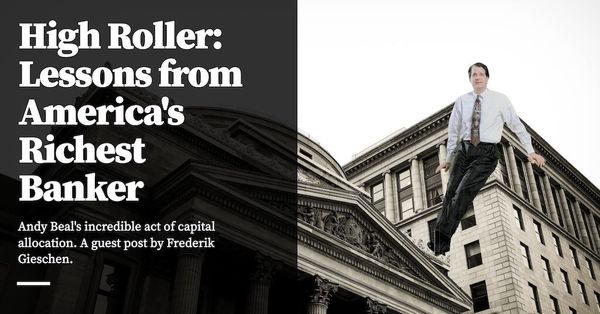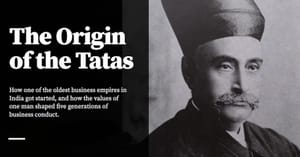Andy Beal's story is an astounding story of capital allocation, incidentally making him America's richest banker. A guest post by Frederik Gieschen.
This is a guest post by Frederik Gieschen, and is Part 8 in a series on the expertise of capital in business. You may read the previous part here.
In our previous entry we looked at how capital allocation can be an antidote to business luck. In the next two instalments I want to walk you through two cases of good capital allocation in action. This week's instalment is one of them.
Frederik Gieschen writes The Alchemy of Money — one of the few Substacks I pay for. A couple of months ago, he published a remarkable piece on American banker Andy Beal — who happens to be a perfect case study for this point in the series, both from the perspective of capital allocation, as well as in the context of the capital cycle.
Gieschen’s piece was for his paid subscribers, and I asked if I could republish it here as part of the capital expertise series. He kindly agreed — but only for Commoncog’s paid members! — which explains this cross posting.
I’m really grateful, because I think you’re in for a treat.
I want to call out two things in the following piece.
First, it’s enlightening to put yourself in Beal’s shoes as Gieschen tells his story, and think about how Beal must have felt as he played against the market. I tend to use a trick I call the “so you have a child” mental exercise — imagine you have a child at the start of (some point) in the story. How old would they be by the end? I’ve found this to be a sobering look at how long some of these stories play out. In this particular case, Beal lay dormant for multiple periods from 1988 onwards. For his coup de grace he had to wait four years starting from 2004 — so, imagine a child born in 1988, 16 years old in 2006, and 20 years old by the end. That’s one childhood right there, up to Beal’s annus mirabilis in 2008. And think about how it must’ve felt to watch his bank shrink around him for the entirety of those four years, 2004 onwards, with no end in sight.
Second, contrast Beal’s story to the Sampo story outlined in our earlier article on the capital cycle. What are some surprising similarities? What are some surprising differences? They both lived through the same crises, though from different sides of the pond.
I’ll let Frederik take over from here.
High Roller: Lessons from America's Richest Banker
“Insurance is not that great a business. It’s a tough game. There are temptations to be stupid. It’s like banking.” — Charlie Munger
“When the music stops, in terms of liquidity, things will be complicated. But as long as the music is playing, you've got to get up and dance.” — Citigroup CEO Chuck Prince in 2007
"Why do people not do the great deals and do all the stupid ones? It's crazy." — Andrew Beal
Even though some industries follow a fairly predictable capital cycle, it seems impossible for their participants to resist the urge to play until it’s too late. Take the mid-2000s in banking. While a few outsiders were sniffing out the big short trade, the insiders were busy trying to get rich while the music was still playing.
All the insiders? No, not all of them.
From 2004 to 2007, Andy Beal did what other bankers could not: he stopped making new loans. His bank’s assets shrunk from $7.7 billion to $2.9 billion.
Beal was “bored stiff”, started coming in late and left early. He took long lunches and spent his time racing cars and playing poker.
He stopped making commercial real estate loans musing that “every deal done since 2004 is just stupid.”
“If I see another office condo in Las Vegas or Phoenix, I'm going to throw up.”
And he started selling loans he had acquired at discounts.
“They were great loans at 85 cents. They're stupid at 115.”
Beal even stopped doing what was considered the safest of banking business, home mortgages guaranteed by Fannie and Freddie. His head of loan purchases recalled salesmen from Countrywide laughing at him when Beal refused to buy securities backed by the government agencies. “Countrywide, Bank of America, Washington Mutual ... every single [mortgage seller] thought we were insane,” he said. “They didn't know why we cared. They thought Fannie and Freddie guarantees were as good as Treasuries.”
They cared because Andy Beal had already figured out that the guarantees were ‘worthless.’
Beal shrank his headcount from 400 to 200 people and tried to rent out half of the space in his headquarters. As his bank seemed to disappear, the credit rating agencies commented he lacked a ‘sustainable business model.’ One of his board members wondered whether they had become ‘a dinosaur’ and bank regulators flat out asked: “What are you doing?”
Beal was undeterred.
Unlike most of his competitors, he had skin in the game.
Beal had built his bank from the ground up, with his own money. And he owned all of it.
If the world wanted to go crazy, it had to do so without him. Beal had always focused on protecting his downside first. He would never, as Buffett put it, “risk losing something that’s very important, to gain something that’s unimportant.”
But he had to be patient.
Beal had expected a credit crunch quickly. “I thought it would end in six months, and sanity would return,” he said. “If I knew it would last nearly four years I would have thought of something else to do.”
For Beal, there was nothing to do but wait.
Wait until the bubble burst, which it eventually did.
Wait until he could scoop up the bargains, which he did.
Originally published , last updated .
This article is part of the Capital topic cluster, which belongs to the Business Expertise Triad. Read more from this topic here→





